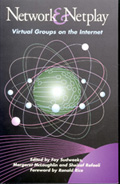 |
Reviews of Network and Netplay: Virtual Groups on the Internet Edited by Fay Sudweeks, Margaret McLaughlin and Sheizaf Rafaeli AAAI/MIT Press ISBN 0-262-262-69206-6, 320pp, $35.00 (paper) Available in January 1998 from The MIT Press . Order book directly from MIT Press or from your local bookstore. |
